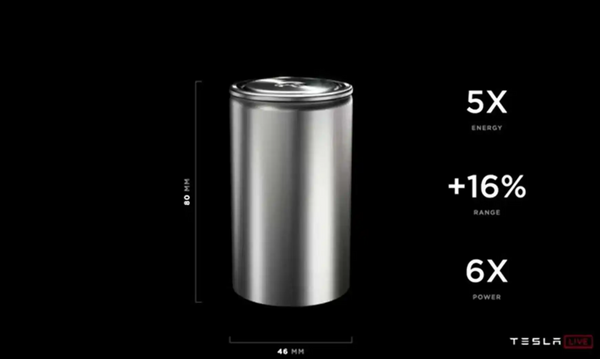Last week, Tesla CEO Elon Musk said at the 2022 Tesla shareholder meeting: "The weekly production of 4680 cylindrical batteries is in line with expectations, and we are confident that mass production will be achieved by the end of the year. At the same time, Tesla is currently The supply of batteries can meet the production needs of 1.5 million vehicles this year."
Since the launch of the 4680 battery on "Battery Day" in September 2020, Tesla has begun trial production at its Fremont factory in California, and the yield rate has risen from the initial 20% to 92%, meeting the mass production requirements.
In February, the output of the Fremont 4680 battery pilot plant exceeded 1 million, arousing widespread concern in the industry.
Since Tesla's own production capacity is still unable to meet the demand for complete vehicles, relevant battery suppliers are stepping up the deployment of 4680 cylindrical battery production lines.
Panasonic plans to mass-produce 4680 batteries at its Wakayama factory in Japan as early as March 2023 to supply Tesla in batches.
LG New Energy said that it will invest 582 billion won in the Ochang plant in South Korea to build a new 4680 cylindrical battery production line, which will start production in the second half of 2023, with an annual production capacity of 9GWh.
Samsung SDI is building a 4680 battery test line for Tesla in Cheonan, South Korea.
In addition to Tesla, many international high-end car companies also take the 46-series large cylindrical battery as the focus of future product development. The 4680 cylindrical battery is expected to penetrate into high-end vehicle manufacturers such as BMW, Porsche, and Daimler.
According to relevant data, the global installed capacity of 4680 batteries will exceed 20GWh in 2023 and 100GWh in 2024.
Under the tuyere, the 4680 cylindrical battery will not only change the production capacity layout of battery manufacturers, but also change the demand in all aspects of the industrial chain.
Based on the characteristics of the 4680 battery, the impact on the equipment mainly includes laser film cutting equipment, coating machine, winding machine high-speed laser filming machine, welding equipment, mid-section assembly equipment, etc.
At present, the series of processes in the battery cell assembly section are the core key points in the production process of large cylindrical batteries, including winding, tab shaping, welding, sealing and other links.
As one of the first equipment companies to realize the trend of large cylinders, Winwin Technology took the lead in developing a complete set of equipment for the middle section of large cylinders, covering from rolling grooves, drying, to primary liquid injection, secondary liquid injection, crimping, spot welding, Cleaning, wrapping to sealing, etc.
At present, the company has provided a number of 46 series large cylindrical mid-section assembly line test lines to many battery companies in the industry.
On the liquid injection stand-alone equipment, the high-speed large cylindrical bell-type liquid injection machine series products developed by Binatus can meet the production cycle of 150PPM of the large cylindrical battery automatic assembly line.
The rapid discharge of 4680 cylindrical batteries will also drive a high demand for new materials. The silicon carbon anode in the anode material standing at the high point of lithium battery technology, the new lithium salt LiFSI in the electrolyte, and the single-walled carbon nanotube CNT in the conductive agent material are all expected to accelerate into the fast lane in the new wave of technology.
Tinci Materials stated on the interactive platform in June that because LiFSI has the characteristics of high temperature adaptability and high conductivity, the proportion of LiFSI will be higher in some current new batteries. With the increase of Kirin batteries and 4680 large cylindrical batteries, it is expected that the proportion of LiFSI formula will also increase. Tinci Materials' LiFSI plant with an annual output of 4,000 tons has now reached a stable production state.
Shanshan Co., Ltd. is one of the few anode material companies in the market with large-scale mass production of silicon-based anodes. Silicon-based anodes continue to lead the global consumer market and have passed multiple rounds of evaluations by mainstream car companies in the field of power battery applications. The large-scale mass production of 4680 batteries is expected to further accelerate the market penetration of Shanshan's silicon-based anodes.
With the continuous improvement of technology in all aspects, the eve of mass production of 4680 batteries has come, and 2023 is expected to be the first year of 4680 cylindrical batteries.
For second-tier battery, material, and equipment manufacturers, the 4680 is not so much a new product as it is a hope to catch up with first-tier manufacturers. As large cylinders are sold in the mid-to-high-end passenger car market, upstream, mid-stream and downstream supply chain companies are expected to open up the second growth curve in the market by relying on their respective technology accumulation in the large-cylinder battery production line.

